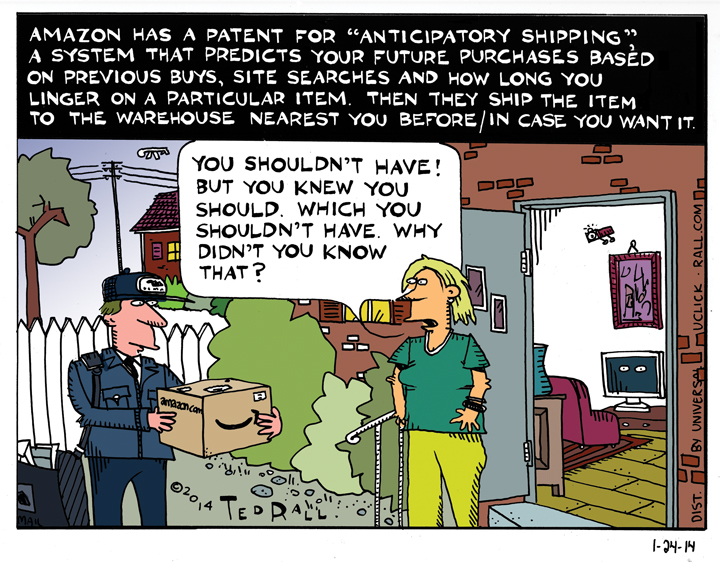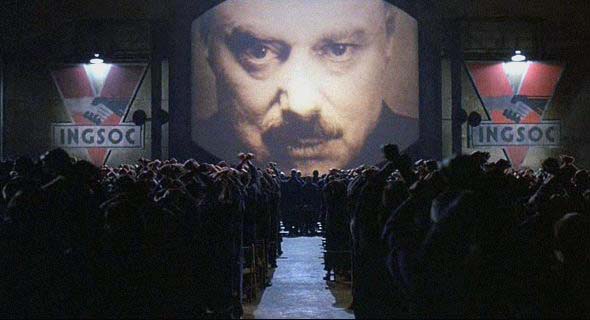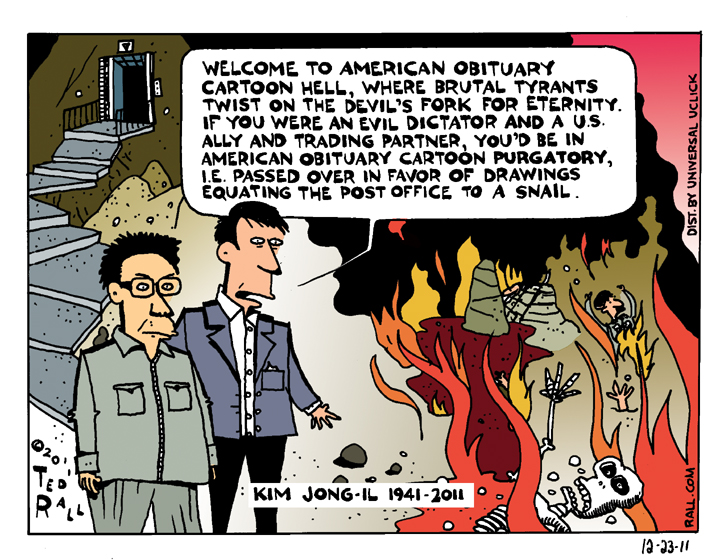Amazon has acquired a patent for “anticipatory shipping,” a system that predicts your future purchases based on previous buys, site searches, and how long you linger on a particular item. Then they ship the item to a warehouse nearest you before/in case you order it. In the future, they may even load it on a truck before you click “buy.”
SYNDICATED COLUMN: “1984” Is Here. Yawn.
Orwell’s Nightmares Come True — But Who Cares?
Another horror no one will care about: the government is spying on your snail mail.
The New York Times timed the release of the story so that it would come and go without notice: on the Fourth of July, when no one reads the paper or watches the news. But buried beneath a puffy lede is yet another privacy-killing whopper. After 9/11, the Times reports, the U.S. Postal Service created something called the Mail Isolation Control and Tracking (MICT) program, “in which Postal Service computers photograph the exterior of every piece of paper mail that is processed in the United States — about 160 billion pieces last year. It is not known how long the government saves the images.”
Just a wild guess? How about: forever?
“Together,” the paper continued, “the two programs show that postal mail is subject to the same kind of scrutiny that the National Security Agency has given to telephone calls and e-mail.” Any government agency — the FBI, local police, etc. — can request mail cover data. As with the rubber-stamp “FISA court,” the USPS almost always says yes to these outrageous mass violations of privacy.
From George Orwell’s “1984”: “As for sending a letter through the mails, it was out of the question. By a routine that was not even secret, all letters were opened in transit.”
“It’s a treasure trove of information,” the Times quotes former FBI agent James Wedick. “Looking at just the outside of letters and other mail, I can see who you bank with, who you communicate with — all kinds of useful information that gives investigators leads that they can then follow up on with a subpoena.” Your finances. Your politics. Your friends.
No doubt about it, the dystopian vision laid out by George Orwell in “1984” is here.
Thanks to NSA leaker Edward Snowden, we’ve learned about the previously top-secret PRISM program, in which the U.S. government “collects the e-mail, voice, text and video chats” of every American to be stored in a $2 billion data farm in Utah, as well as sweeping telephone surveillance by Verizon and other telecommunications companies on behalf of the NSA. According to NBC News and other sources, “every single phone call made in the U.S. has been monitored by the U.S. government.” And not, merely, as President Obama and his media shills keep saying, “just” (!) the metadata. Under ECHELON, they listen in to “all telephone, fax and data traffic,” record it, and store it.
From “1984”: “There was of course no way of knowing whether you were being watched at any given moment. How often, or on what system, the Thought Police plugged in on any individual wire was guesswork. It was even conceivable that they watched everybody all the time. But at any rate they could plug in your wire whenever they wanted to.”
Yes they can.
The dominant eavesdropping technology in “1984” was a device called the “telescreen.” Installed in every home and workplace as an outlet for government propaganda, Orwell’s telescreen “received and transmitted simultaneously. Any sound that Winston made, above the level of a very low whisper, would be picked up by it, moreover, so long as he remained within the field of vision which the metal plaque commanded, he could be seen as well as heard.”
Which sounds a lot like the creepy new two-way TV — you watch it and it watches you — for which Verizon filed a patent application in 2011. This TV would target “ads to viewers based on information collected from infrared cameras and microphones that would be able to detect conversations, people, objects and even animals that are near a TV. If the detection system determines that a couple is arguing, a service provider would be able to send an ad for marriage counseling to a TV or mobile device in the room,” reported the blog Fierce Cable. “If the couple utters words that indicate they are cuddling, they would receive ads for ‘a romantic getaway vacation, a commercial for a contraceptive, a commercial for flowers,’ or commercials for romantic movies, Verizon states in the patent application.”
Verizon’s patent was denied. But now Google TV is going for it. The technology exists; it’s only a matter of time before it finds its way into our homes. Anti-privacy tech types point out it’s only to make ads more effective — the same way web ads react to your searching and browsing. But that’s just for now. It isn’t a stretch to imagine the NSA, FBI or other crazy spook outfit tapping into America’s telescreens in order to watch us in our living rooms and bedrooms.
Gotta stop the terrorists! Whatever it takes.
Ah, the terrorists. The enemies of the state. Bush had his Osama; Obama has Snowden. Bugaboos keep us distracted, fearful, compliant. “The heretic, the enemy of society, will always be there, so that he can be defeated and humiliated over again,” the government official goon O’Brien lectures Winston Smith in “1984.” “The espionage, the betrayals, the arrests, the tortures, the executions, the disappearances will never cease.”
They can’t.
Governments rule over the governed either by obtaining their tacit consent, or by crushing potential opponents by making them afraid to speak up. Option two is where we are now.
One horror follows another. At Guantánamo concentration camp, where les misérables of America’s War of Terror languish for year after year, uncharged with any crime, U.S. government goons announced that they will continue to force-feed more than 100 hunger strikers during Ramadan, a month-long holiday when devout Muslims are required to fast. WikiLeaks founder Julian Assange is trapped in the Ecuadorean embassy in London because he fears extradition to and execution by the U.S.; Ecuador has discovered that some Western intelligence agency planted a bug to watch him. Meanwhile, Edward Snowden has been de facto stripped of his U.S. citizenship, his passport canceled, rendering him effectively stateless. Meanwhile, the megacriminals he exposed — Obama and his cronies — are living large.
Assange and Snowden are no longer important. They’ve done all the damage they can do. But the U.S. will never leave them, or any other enemy of the state, alone. It’s about terrifying potential political opponents into submission.
“Do not imagine that you will save yourself, Winston, however completely you surrender to us. No one who has once gone astray is ever spared,” O’Brien tells Winston. “We shall squeeze you empty, and then we shall fill you with ourselves.”
Enjoy your barbecue.
(Ted Rall’s website is tedrall.com. His book “After We Kill You, We Will Welcome You Back As Honored Guests: Unembedded in Afghanistan” will be released in 2014 by Farrar, Straus & Giroux.)
COPYRIGHT 2013 TED RALL
SYNDICATED COLUMN: Stamped Out
The Statue of Liberty Stamp Error and the End of America
It may seem like a minor thing. Objectively it is a minor thing. But the Great Statue of Liberty Stamp Screw-up of 2011 presents a picture-perfect portrait of a society in the midst of collapse.
You can tell a lot about the state of a country from its stamps and its currency. At a nation’s peak its graphic iconography tends to be striking, elegant and original. As it begins to wane abstraction gives way to self-caricature, innovative design to self-parody, high art to kitsch.
Look at U.S. stamps and paper money from 100 or 50 or even 30 years ago and you’ll see my point. Quarters were nearly sterling silver; now they’re mystery metal (nickel-copper-zinc alloy).
America: we’re not what we used to be.
A century ago President Theodore Roosevelt commissioned the famous Beaux Art sculptor Augustus Saint-Gaudens to redesign the nation’s coinage. Among the results were Saint-Gaudens’ breathtaking $20 gold “double eagle”; numismatists consider it one of the most elegant coins of the 20th century.
How the mighty have fallen! According to U.S. Mint officials recent revamps of the $100, $50, $20, $10 and $5 bills were undertaken without the slightest consideration for aesthetics. They didn’t even consult an art director. Stymieing counterfeiters was the sole concern.
Now the U.S. Postal Service has issued its newest first-class “forever” stamp. As the most widely used denomination, a new forever is a big deal.
The new stamp features a photo of the head of the Statue of Liberty. Well…not exactly. Instead of the Statue of Liberty paid for by coins donated by French schoolchildren, the proud iconic figure which has greeted millions of immigrants to New York, the stamp bears the visage of the small replica which stands in front of the New York-New York casino in Las Vegas.
Mistakes happen. As every philatelist knows, another error—the 1918 “Jenny Invert,” which features an image of an upside-down airplane—is one of the most prized collectibles in philately because Post Office officials destroyed all but one sheet of the 100 stamps.
That’s the usual response to a catastrophe in stampdom. Ten years ago Postal Service recalled and destroyed the entire run of a stamp that wrongly placed the Grand Canyon in Colorado.
But that was before the economic collapse that began in 2008. The Postal Service is broke. Quality standards? Can’t afford them. Incredibly, postal officials are allowing this monstrosity, this bastard creation, this artistic obscenity—the face is clearly the wrong one—to be sold at your local post office.
“We still love the stamp design and would have selected this photograph anyway,” USPS spokesman Roy Betts told The New York Times.
Uh-huh.
“The [postal] service selected the image from a photography service, and issued rolls of the stamp bearing the image in December,” reported the newspaper. “This month, it issued a sheet of 18 Lady Liberty and flag stamps. Information accompanying the original release of the stamp included a bit of history on the real Statue of Liberty. Las Vegas was never mentioned.”
It’s bad enough that they use photographs. Stamps should be engraved. Engraved stamps look classier and more substantial.
But whether they are using an engraver, illustrator or photographer, a U.S. stamp ought to be a big gig. For an assignment such as this I would expect the USPS to hire a professional and pay huge money—six-figures huge. It’s a stamp, for Chrissake.
Nope. The U.S. Postal Service buys stock photos. For stamp design. That’s right—the same cheesy clipart you can download for your kid’s birthday party invitation.
Insane.
In and of itself, this is no big deal. These are lean times. Austerity abounds. Why not save a few bucks?
It matters because symbolism matters. The kind of country that puts stock photos on its stamps is the kind of country that puts a single air traffic controller in charge of one of its biggest airports. The kind of country that doesn’t fix its mistakes is the kind that tells people under the age of 55 that they can go to hell and die when they get old and sick because it’s more important to cut taxes for rich scum than to fund Medicare.
As for the symbolism of a phony Statue of Liberty that stands in front of a casino in the nation’s gambling capital—well, that’s obvious.
It would be fine if the money being saved by printing crappy stamps went to new textbooks in inner-city schools. But it doesn’t. It goes to Halliburton and Bill Gates. Now that American workers have been hung out to dry, robbed and fleeced, wrung out and burned out, the government and its associated agencies (the USPS is quasi-governmental) have turned on themselves in service to the 21st century robber barons.
Don’t get mad about the stamps. Get mad at what they mean.
(Ted Rall is the author of “The Anti-American Manifesto.” His website is tedrall.com.)
COPYRIGHT 2011 TED RALL



